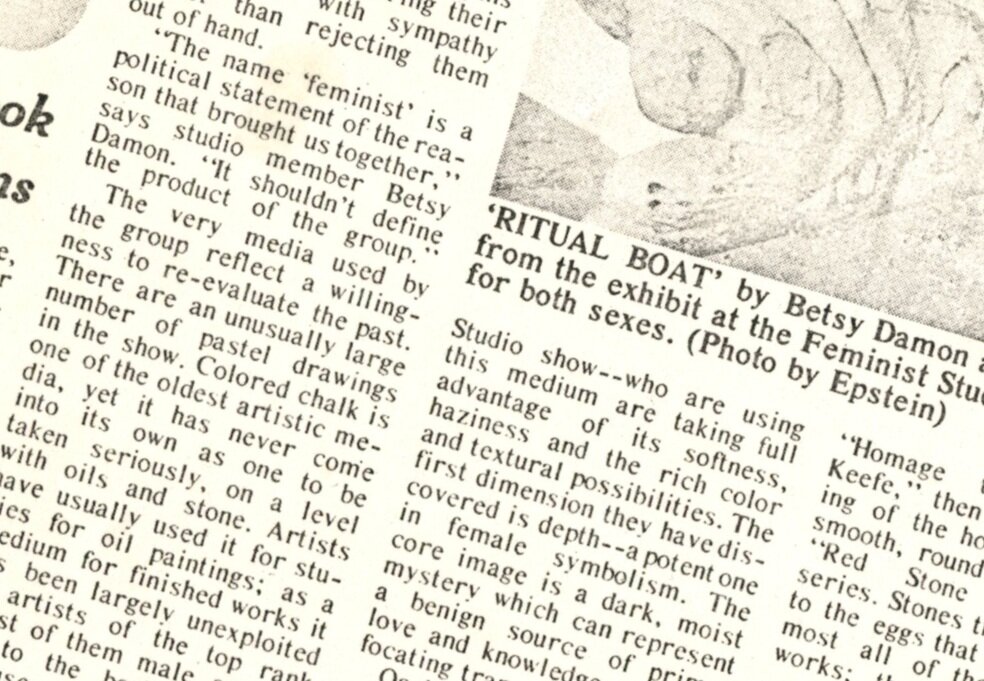
Press
An Honest Look at Old Dreams
“…feminism rests easy on these artists. They are past cutting themselves off from their heritage as women.”
ITHACA NEW TIMES, OCTOBER 13, 1974
The hotel room is white, lit softly by a single boudoir lamp. A yellowed satin wedding gown hangs over the end of the bed. Its lace veil, brown with age, is laid out on a white table beside two white candles, a lamp, a small photograph taken long ago of a woman holding a bicycle, a fading lily, a dead white moth. On the rumpled chenille bedspread lies the naked white bride, her lips and legs slightly apart. But only a few black accents evidence the groom—his shoes, his tuxedo, his bow tie placed among the carefully arranged objects on the table.
The bride is plaster, the room a sculpture—for this is Sarah Tamor Oschrin's “Honeymoon Suite: My Childhood Wedding Night Fantasy.” A gauzy curtain separates this shrine to old dreams from the loft of the Feminist Studio at 136 E. State St., where a group exhibition by studio members was held in conjunction with the recent Feminist Celebration.
The overwhelming impression I received from the show was that the mantle of feminism rests easily on these artists. They are past cutting themselves off from their heritage as women, and are not ashamed or afraid of the cliches of femininity. As Oschrin's piece demonstrates, they are confronting the old myths and dreams, exploring their significance with sympathy rather than rejecting them out of hand.
“The name 'feminist' is a political statement of the reason that brought us together," says studio member Betsy Damon. "It shouldn't define the product of the group.”
The very media used by the group reflect a willingness to re-evaluate the past. There are an unusually large number of pastel drawings in the show. Colored chalk is one of the oldest artistic media, yet it has never conic into its own as one to be taken seriously, on a level with oils and stone. Artists have usually used it for studies for oil paintings; as a medium for finished works it has been largely unexploited by artists of the top rank (most of them male, according to the books), perhaps because the soft luminosity of carefully finished pastel "paintings," as opposed to quick, rough color studies, was considered too "polite," too "feminine," better left to the drawing-room amateur who wanted the color effect of oil painting without the mess or commitment. This sexist interpretation may he pushing things a hit, but it would appear historically that much of the serious work in pastel has been done by women, such as Mary Cassatt. or at least about them, as in the case of Degas' famous ballerinas.
The eight women—out of the dozen or so in the Feminist Studio show—who are using this medium are taking full advantage of its softness, haziness and the rich color and textural possibilities. The first dimension they have discovered is depth—a potent one in female symbolism. The core image is a dark, moist mystery which can represent a benign source of primal love and knowledge or a suffocating trap.
Oschrin's vaginal symbolism is pretty straightforward in drawings with titles like "Angry Rose Opening" and "Tunnel." She often uses cupped hands or the space between thumb and forefinger to delineate the image, juxtaposing traditionally passive and active metaphors. Others among the artists, especially Ann Hollingsworth, Joy Martin and the team of Betsy Damon and Debby Jones, use imaginary, somewhat surrealistic landscapes as the context for the subtler male implications of valleys, folds and undulations. A new dimension of female symbolism opens when the negative space of the vagina metamorphoses into a positive one through the shell.. Damon-Jones use it in "Homage to Georgia O'Keefe," then close the opening of the hollow to become smooth, round stones in their "Red Stone Landscapes" series. Stones then transform to the eggs that appear in almost all of these women's works; the circle is completed in the primary spherical image of Oschrin's "Uterus."
Of course, the content of pastels in the show is not limited to abstract symbolic forms; alongside the search for a new female ethos there is a purely artistic excellence in drawing. I was impressed by the sheer technical virtuosity in most of these drawings; they are as fully realized as any painting.
The show as a whole has a coherent group meaning because of this symbolic language, which extends through all media. Kathy Morris has a series of small acrylic still fifes, starkly realistic renderings of strange little knickknacks that look as if they'd been photographed with a box camera and a harsh direct flash; they, too, have eggs and shells amid the green plastic dinosaurs.
Damon and Jones are also working on a wood sculpture, "Ritual Boat," that is slung from the ceiling like the carved Indian canoes of the Northwest. Its lovely tactile surface seems to be developing in breast-like humps. Next to it on the floor is a group of hand-hewn wood "boulders" on a bed of shavings that look like nothing if not a nest of giant eggs.
There are a lot of collages, too, which, if not particularly stimulating in themselves, must have some meaning in terms of the entire studio output. And then there's the work of Susan MacKay, which defies categorization, but shows wonderful skill and imagination. The exhibit is encouraging and rich with value and significance for both sexes.
—Stephanie M. Brown